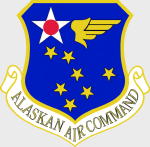Hobby Master HA3101 USAF Convair F-102 Delta Dagger Interceptor - 317th Fighter Interceptor Squadron, 21st Composite Wing, Alaskan Air Command, Alaska, 1960s (1:72 Scale)
"Top Cover for America"
- Principal role of the Alaskan Air Command
 The Convair F-102 Delta Dagger was a US interceptor aircraft built as part of the backbone of the United States Air Force's air defenses in the late 1950s. Entering service in 1956, its main purpose was to intercept invading Soviet bomber fleets.
The Convair F-102 Delta Dagger was a US interceptor aircraft built as part of the backbone of the United States Air Force's air defenses in the late 1950s. Entering service in 1956, its main purpose was to intercept invading Soviet bomber fleets.
The F-102 was the first operational supersonic interceptor and delta-wing fighter of the USAF. It used an internal weapons bay to carry both guided missiles and rockets. As originally designed, it could not achieve Mach 1 supersonic flight until redesigned with area ruling. The F-102 replaced subsonic types such as the F-89 Scorpion, and by the 1960s, it saw limited service in Vietnam in bomber escort and ground attack roles. It was supplemented by F-101 Voodoos and, later, by F-4 Phantom IIs. Many of the F-102s were transferred to United States Air National Guard duty by the mid-to-late 1960s, and the type was retired from operational service in 1976. The follow-on replacement was the Mach 2 class F-106 Delta Dart which was an extensive redesign of the F-102.
Pictured here is a 1:72 scale rendition of a Convair F-102 Delta Dagger interceptor that was attached to the 317th Fighter Interceptor Squadron, 21st Composite Wing, then deployed with the Alaskan Air Command, Alaska, during the 1960s.
Sold Out!
Dimensions:
Wingspan: 6-1/4-inches
Length: 11-1/4-inches
Release Date: October 2010
 Historical Account: "Cold as Ice" - Alaskan Air Command (AAC) (1945-1990) was a Major Command of the United States Air Force (USAF) charged with early warning of an aerial attack on the United States or Canada.
Historical Account: "Cold as Ice" - Alaskan Air Command (AAC) (1945-1990) was a Major Command of the United States Air Force (USAF) charged with early warning of an aerial attack on the United States or Canada.
During the Cold War, Alaska became strategically important in posturing against threats from the Soviet Union. The vast construction completed during World War II brought Alaska distinctly into a new age and into the American consciousness. The United States Army Air Forces Eleventh Air Force became the Alaskan Air Command (AAC) on 18 December 1945, and its headquarters was moved from Davis AAF to Elmendorf AAF on 1 October 1946 to manage Alaska's emerging air defense system.
Alaskan Air Command was divided into two air defense sectors - Aleutian and Yukon. The defense of the Yukon sector was directed from Ladd AAF, near Fairbanks, Alaska. During the summer of 1947 the Aleutian sector was deactivated, and defense operations were centered at Elmendorf and Ladd.
Alaska's air defenses greatly expanded during 1945-1955 period. The United States built an extensive aircraft control and warning (AC&W) system along Alaska's coast and interior. The Alaskan segment of the Distant Early Warning (DEW) Line was built, and later the DEW Line was extended to the Aleutian Islands. The Command was initially equipped with P/F-51 Mustangs, which were replaced in succession by F-82H Twin Mustangs, F-80 Shooting Stars, F-94 Starfires, F-89 Scorpions and F-102 Delta Daggers in the air defense role.
By 1957, Alaskan Air Command had reached its peak strength with over 200 fighter interceptors assigned to six Air Defense squadrons in addition to Strategic Air Command elements operating through and around Alaska, and performing other operational support missions as directed by the Commander-in-Chief, Alaskan Command HQ and Headquarters USAF. AAC maintained Fifteen major air force bases, Eighteen aircraft control and warning sites and 12 DEW Line locations provided early warning and fighter direction. The White Alice Communications System tied the network together. AAC's assigned strength was 20,687. The forces were organized into two air divisions (10th and 11th AD) providing "Top Cover for America."
The late 1950s and the 1960s saw a major reduction in AAC's forces as Air Force air defense doctrine began changing, and emphasis shifted to a defense against a mixed threat of missile and bomber attacks. The number of fighter interceptor squadrons shrank to one, the air divisions were inactivated, and the aircraft control and warning sites declined to 13. The assigned strength dropped to 9,987 in 1969. The Aleutian DEW Line segment was dismantled. Emphasis shifted towards supporting other commands.
The F-102s were replaced with McDonnell-Douglas F-4E Phantoms in 1970. The arrival of the versatile F-4E marked another turning point in AAC's history. It gave AAC a tactical air-to-ground attack capability.


